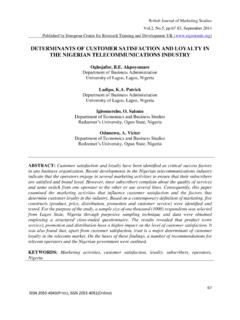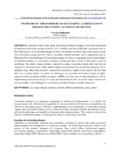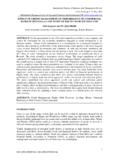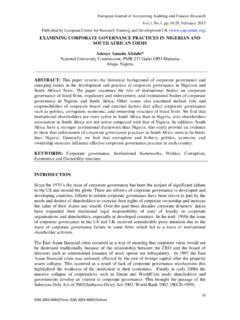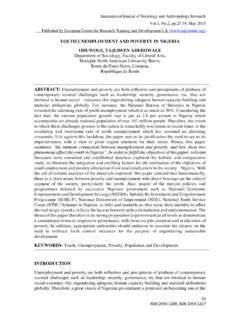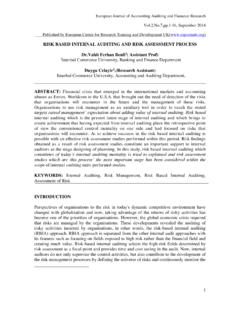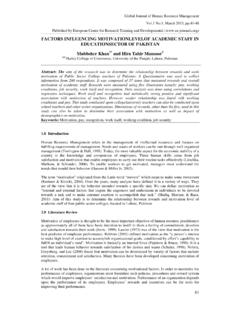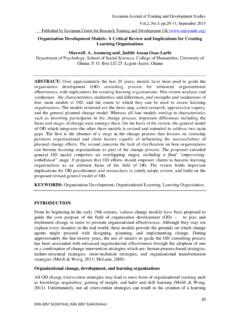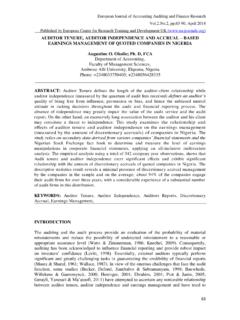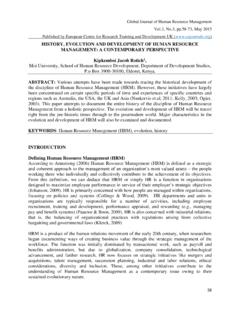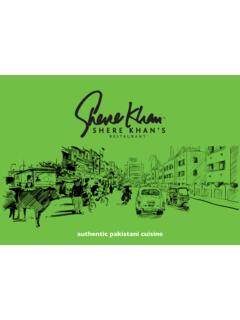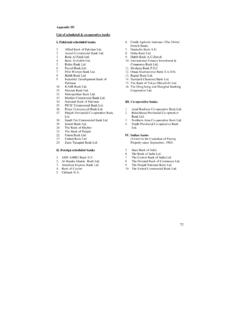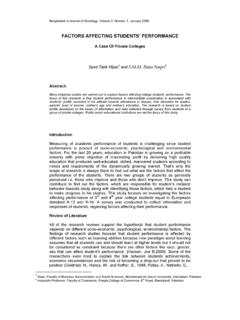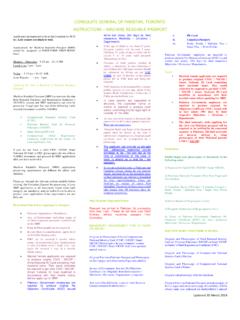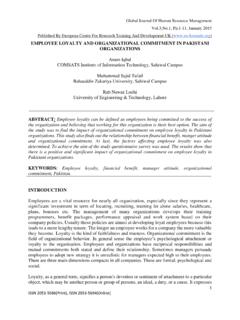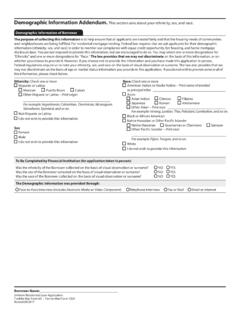Transcription of TEXTBOOK ANALYSIS AND EVALUATION OF 7 & 8 GRADE …
1 International Journal of English Language Teaching , , , June 2015 Published by European Centre for Research Training and Development UK ( ) 79 ISSN 2055-0820(Print), ISSN 2055-0839(Online) TEXTBOOK ANALYSIS AND EVALUATION OF 7TH & 8TH GRADE IN PAKISTANI CONTEXT Gul Fatima Department of Applied Linguistics, GC University, Faisalabad, Pakistan Syed Kazim Shah Lecturer, Department of Applied Linguistics, GC University, Faisalabad, Pakistan Humail Sultan Department of Applied Linguistics, GC University, Faisalabad, Pakistan ABSTRACT: TEXTBOOK EVALUATION has become a necessary practice in the field of teaching, seeking to assist in the choice of the best suitable book for a specific context. This paper presents an ANALYSIS and EVALUATION of English textbooks Step Ahead 2 and Step Ahead 3 for 7th and 8th class respectively. The researcher identifies how well a pre-use TEXTBOOK matches the needs of a learning program and how much appropriate the activities are.
2 The books have been analyzed impressionistically and with in-depth terminology. The results suggests some problematic areas that textbooks need improvement regarding the four skills and culture representation. There is an exposure of only foreign culture and basic skills are not emphasized equally. The findings accentuate the need to revisit the material by the authors that would contribute to the improvement of the English textbooks at these levels. KEYWORDS: TEXTBOOK EVALUATION , pre-use EVALUATION , impressionistic method, in-depth method, checklist method. INTRODUCTION The term EVALUATION generally applies to the process of making a value judgment. According to Hutchinson and Waters (1987), EVALUATION is the matter of judging the fitness of a something for a particular purpose . In education, the term EVALUATION is used in reference to operations associated with curricula, programs, interventions, methods of teaching and organizational factors.
3 It is a sophisticated concept which includes the phases of selecting the information, analyzing, transferring, using and making a decision on the quality of the curriculum. Curriculum EVALUATION is a necessary and important aspect of any national education system. It provides the basis for curriculum policy decisions, for feedback on continuous curriculum adjustments and processes of curriculum implementation. Cronbach (1963), states that EVALUATION process should be focused on gathering and reporting information that could help guide decision making in an educational program and curriculum development . Therefore, EVALUATION of TEXTBOOK is also considered to function as a kind of educational judgment. Textbooks are considered as an essential component of any ESL course and thus the selection of the best suitable book for a particular context demands careful investigation. A TEXTBOOK can be referred to as a published material specially designed to help language learners to improve their linguistic and communicative abilities (Sheldon 1987).
4 The use of ESL published materials is more widespread than ever before since textbooks provide ESL teachers with guidelines concerning syllabi, teaching methodologies and the materials to be taught. The International Journal of English Language Teaching , , , June 2015 Published by European Centre for Research Training and Development UK ( ) 80 ISSN 2055-0820(Print), ISSN 2055-0839(Online) content in the textbooks should be persuasive enough to induce all the requisite skills suited to an esteemed society in the students. If the TEXTBOOK is too advanced or too simple for the students the teacher will inevitably be faced with problems. In the selection of a TEXTBOOK , it is important to conduct an EVALUATION to ensure that whether it is suitable or not. In addition to being a learning instrument, textbooks are also used as a supporting teaching instruments. The student s book usually comes with other materials such as workbook, a teacher s book or even additional multimodal texts for reference as a TEXTBOOK package (Masuhara and Tomlinson 2008).
5 All these things are designed to give a cohesion to the learning and teaching and to make it more authentic. In this study, the textbooks that have been selected for EVALUATION are written by two co-authors Heather Jones and Robyn Mann and it was published in 2002. It consists of a TEXTBOOK , a workbook, and an audio CD. The authors claim that the pupil s age, needs, interests and prior knowledge has been taken into consideration in the design and planning of the course. The authors also state that the activities inside the TEXTBOOK are of communicative nature and encouraged learner s autonomy and critical thinking. For the verification of their claim, a checklist has been developed for qualitative and quantitative EVALUATION by following McGrath terminology. Prior to the ANALYSIS of textbooks, it is necessary to conduct a preliminary ANALYSIS of the context in which the material is going to be used and a survey of the learner s needs The pre-use or predictive EVALUATION (Ellis, 1997; McGrath, 2002; Tomlinson, 2003), helps in defining which materials are best suited to the teaching purposes and learner s needs prior to implementation.
6 Littlejohn (1998) observes that TEXTBOOK EVALUATION serves the purpose of examining whether the methodology and content of the materials are appropriate for a particular language teaching context. Whether they truly develop autonomy, or they truly involve problem solving and if they indeed are learner centered. Therefore, in this study, the core of systematic TEXTBOOK EVALUATION is to examine how well a pre-use TEXTBOOK matches the needs of a learning program and how much appropriate the activities are. Needs ANALYSIS has been done prior to TEXTBOOK EVALUATION . As Hutchinson and Waters (1987: 54) point out, what is meant by needs ANALYSIS here is ultimately the ANALYSIS of the target situation needs the kind of language that the learners have to acquire to cope in the target situation. Tudor (1996), regarded target situation and learning needs ANALYSIS as objective and subjective needs ANALYSIS respectively. The former collects information about the actual requirements for language use as they exist in the target situation, while the latter addresses subjective perceptions of the course participants about what they feel the course should be like.
7 Although, the TEXTBOOK under scope in the present study is being used in Pakistani renowned school, pre-use ANALYSIS has been used due to limitations of the researcher to obtain information of the actual use of the book and the way it was received by teachers and students. The pre-use ANALYSIS would serve to examine the TEXTBOOK as it is, with the content and ways of working which they propose and not with what may actually happen in classrooms. LITERATURE REVIEW Fredriksson and Olsson (2006), conducted a qualitative research to investigate criteria for selecting English textbooks. They investigate how English teachers in one specific upper secondary school solve the task of selecting English textbooks. The data was collected through International Journal of English Language Teaching , , , June 2015 Published by European Centre for Research Training and Development UK ( ) 81 ISSN 2055-0820(Print), ISSN 2055-0839(Online) interviews and in-depth study proposed by McGrath (2002).
8 The results revealed that most important criterion to consider in the selection is, according to the teachers, interesting and relevant texts that the students can relate to. Varying and motivating texts are significant for both teachers and students. Similarly, Perveen (2011), also conducted her study to evaluate the curriculum at the primary level in the light of education policies and plans in Pakistan. The article discusses the objectives of the curriculum at the primary level and analyzes different education policies and plans regarding the achievements of objectives. Results revealed that the objectives of curriculum were not fully achieved. The procedure of the implementation of policies and plans regarding curriculum remained weak. Aftab et al (2014), analyzed and evaluated the TEXTBOOK Prose and Heroes and explored the degree it benefited both for learners and teachers. The purpose was to contribute to the improvement of English language programs in Pakistani colleges.
9 The study was exploratory and descriptive in nature. For the ANALYSIS , questionnaires and semi structured interviews had been used as a tool. The results revealed that relevant TEXTBOOK did not cater to the needs of learners. Hatoss (2004), presented a model which can be used for evaluating language textbooks in terms of their adequacy in teaching culture and developing intercultural skills. The model is based on theories of culture and theories of language learning. Her model is based on three dimensions: input, method, aims. She opines that a TEXTBOOK should represent the culture of the target society too and EVALUATION criteria should also focus on the cultural aspects given in the TEXTBOOK . Models are necessary to provide a conceptual framework for designing a particular EVALUATION depending on the specific purpose of the EVALUATION . The models differ in many of their details, the decision to choose an EVALUATION model depends on a few important factors such as the EVALUATION questions, the issues that must be addressed, and the available resources (Madaus & Kellaghan, 2000).
10 Cunningsworth (1984), in his book Evaluating and Selecting EFL Teaching Materials also proposed a checklist of questions which summarizes the criteria for EVALUATION . There can be different methods of EVALUATION . McGrath (2002), presents some methods of EVALUATION in his book Materials EVALUATION and Design for Language Teaching . One of the methods he explains is the checklist method, where essential criteria are listed and systematically checked off. Other methods are the impressionistic and in-depth method which means that materials are chosen for thorough examination. McGrath (2002) recommends pre-use EVALUATION , in-use EVALUATION and post-use EVALUATION . This means that the material should not only be evaluated before being used, but constantly while using it as well as after use. McGrath s basic explanation of TEXTBOOK EVALUATION concerns the discovery of whether what you were looking for was there. When found, you then need to put a value on your findings.
